1 – Kerb & front door appeal
Never underestimate the value of a well presented exterior. The house with the ‘white picket fence and climbing rose’ comes to mind; this is the house that everybody admires and by which travel directions are given. In order to maximise kerb appeal it is important that the grass is cut, the flower beds weeded, loose paving is fixed, the door-bell works, the windows are clean,
the garden tap doesn’t drip and there are fish in the fish pond.
The list of repairs and ‘to dos’ can be endless but are essential when you consider it takes buyers no more than eight seconds to decide whether they like a house and a few of these are spent
waiting at the door. A defining feature, and one of the first things that potential buyers will see when they arrive at your home is your front door. Bright and beautiful or subtle and sophisticated a front door has a big impact on buyers’ first impressions and if not in good repair it sends out all the wrong signals.
A fresh lick of paint doesn’t take long to apply (but make sure to prepare the surface well before you reach for the brush!) and can totally transform the look of a home. Pick a colour that best suits the style and character of the property; look online for inspiration. Be sure to have door furniture gleaming; if it’s worn or dull looking consider replacing it and remember to invest in quality (people will be able to tell by the feel). Choose door knockers and letterboxes in keeping with the style of your property: brass will suit a period home and for a contemporary look opt for chrome or brushed aluminium. House numerals should be well positioned and easy to read.
To make a good impression, plants surrounding the door can be almost as important as the door itself. A climbing plant or creeper always adds allure but dead leaves must be tended to. Roses and jasmine have universal appeal and clipped box or bay to either side of a front door make for a tidy composition. As for window boxes, these miniature gardens can truly transform a property; they can be planted in any season to add texture, colour, interest and charm.
2 – Outdoor living space
Few things have more ‘lifestyle’ appeal than an outdoor living area, where potential buyers can picture themselves sipping a glass of wine after work, having friends around for a barbecue or simply sitting on a bench with a book. Making the most of any outdoor space, be it large or small, is therefore a good investment. Whether you are setting the scene by providing table and chairs for alfresco entertaining on the terrace or creating a cosy nook in a tiny garden with a bench or bistro table for two, you will be increasing the living space of your home while sparking the imaginations of potential purchasers.
Equally with apartments, even if your balcony is the size of a postage stamp, it is an extension of your living space and should be included in the staging of your property. Dress it up with a café table and chairs and let buyers imagine themselves reading the paper and having breakfast outdoors.
3 – The kitchen & bathroom
Even though upgrading your kitchen from a tired and dated style to a more contemporary look with modern spacious storage units is one of the best investments you can make, when budgeting remember that any home improvements should be in line with the value of a home – don’t spend more than 20 per cent of the house value on your kitchen makeover. Don’t blow the budget on finishes, appliances or cabinetry that won’t add much value or ones that will date quickly.
Sometimes basic home maintenance can pay greater dividends than a new kitchen or bathroom – you might be better off painting the cabinets, replacing handles, splash backs and countertops as opposed to buying a completely new kitchen. The right lighting and appliances can increase the appeal factor too. For bathrooms, the same precepts apply as for the kitchen but also consider whether your money might be better spent in adding value by converting the spare room into a family bathroom or en-suite. Always remember to select design classics in sanitary ware, tiles, paint colours, cabinetry etc.
As with kitchens not everyone has the ‘perfect’ bathroom; renovations can be costly and sometimes it is a better strategy to work with what you have. When even an extreme clean doesn’t get rid of unsightly stains it’s time to re-grout and re-caulk your bathroom. If you’re going to replace fixtures and fittings consider off-the-floor wash hand basins and wcs to make small spaces appear bigger. Updating light fittings, towel racks and door furniture is less expensive and can have a similar effect.
4 – The spare room
Instead of having it as the dumping ground consider converting it into useful space such as an office, guest room, en-suite, extra bathroom, or nursery. Rooms with a function other than storage will add more value by showing off their potential.
5 – The feel: tidy and clean
Cleaning the house will have the greatest impact on the feel so make sure it’s gleaming. Add a lick of paint wherever necessary – no single effort can do more or provide a greater return on investment. Whites and neutrals when used on walls provide the perfect canvas against which any potential buyer can imagine their belongings.
Walk-in wardrobes should be ‘walkin-able’; take half the stuff out and neatly organise what’s left allowing for at least 20 to 30 percent free space. If you are using your attic space for storage make sure it’s clean, tidy and well-lit. Our brains love symmetry and whether we are aware of it or not a ‘balanced’ interior is not only aesthetically pleasing but creates a feeling of harmony in a space; two-seater sofas positioned opposite each other with a coffee table and rug between them is a familiar configuration.
All rooms and circulation areas should be easy to navigate and kept obstacle free. Any spare chairs or armchairs should be put into storage, or space permitting used to add seating areas to bedrooms; counter intuitively, a chair in the corner of the room or bench at the end of a bed will give the impression that the room is larger.
Small Jobs
Unfinished repairs can reflect badly on the overall maintenance of a property, creating an impression that there is a lot of work to be done. Assuage potential cause for concern and ensure
outstanding odd jobs are completed by fixing door handles, stuck drawers, squeaky floorboards and the like.
Market Value
Efficient central heating systems, double glazing, secure doors and windows, and a garden top UK home-buyers’ lists of must-have home features, according to price comparison website GoCompare. ‘Friendly neighbours’ and a parking place slip down the list as compared to their 2017 survey, while open plan living spaces, highly rated schools and period features all fail to make the top 20.
A reliable broadband connection has moved up into the top five home essentials from 8th last year, while a clear mobile signal and a good energy efficiency rating are both in the top 10 for the first time. Other property features on buyers’ ‘must-have’ lists include plenty of electrical sockets, easy access to local shops and other amenities, at least two toilets, a bath tub, a shower cubicle and cavity wall insulation.
Other research, this time from the Federation of Master Builders (FMB), the Homeowners Alliance (HOA) and The Guild of Property Professionals, shows that the following additions increase the value of a home (listed from most to least):
- Removing an internal wall to create an open plan kitchen and dining
- Building a garden room or outside playroom for the kids
- Converting a cupboard under the stairs into a downstairs toilet
- Converting part of the master bedroom into an en suite bathroom
- Building a new driveway
- Installing decking and lighting in the back garden




















